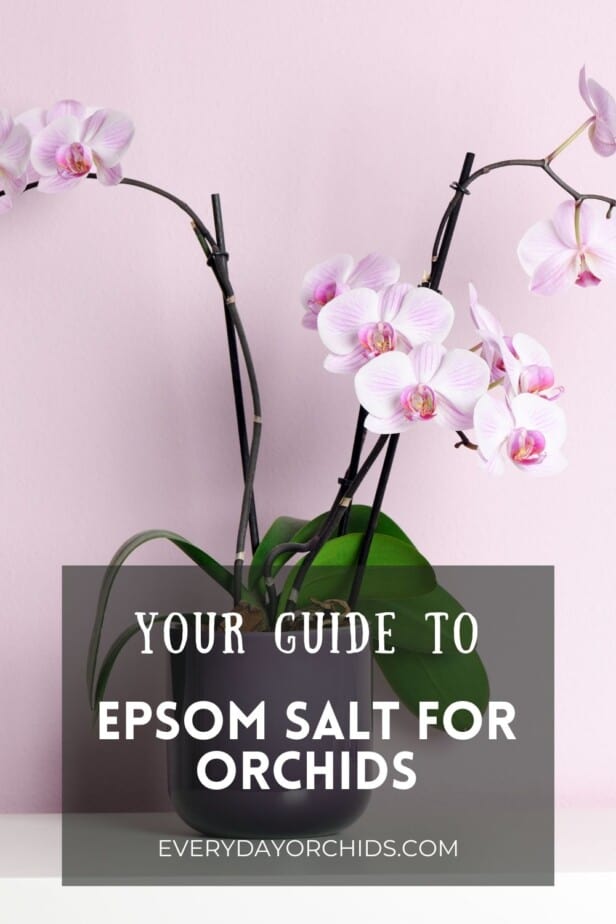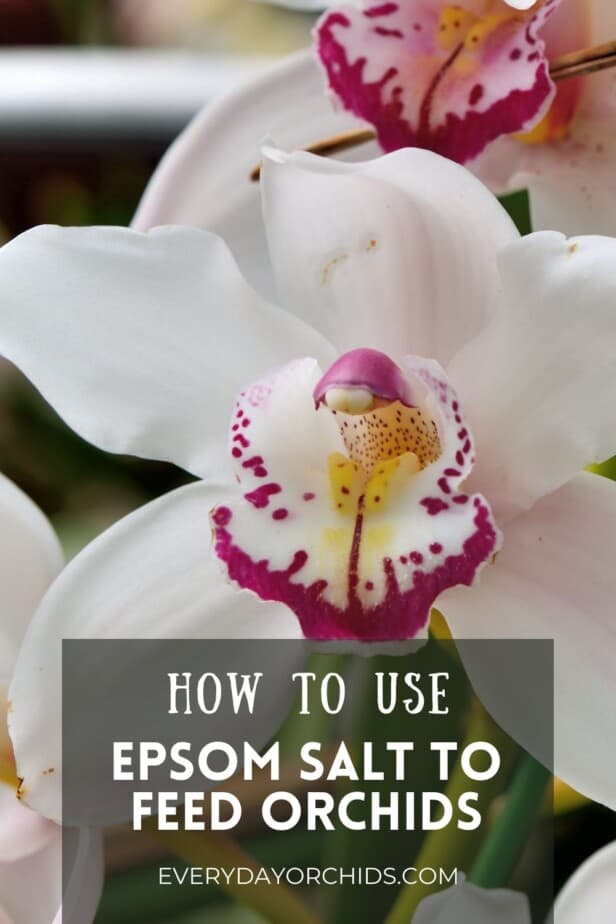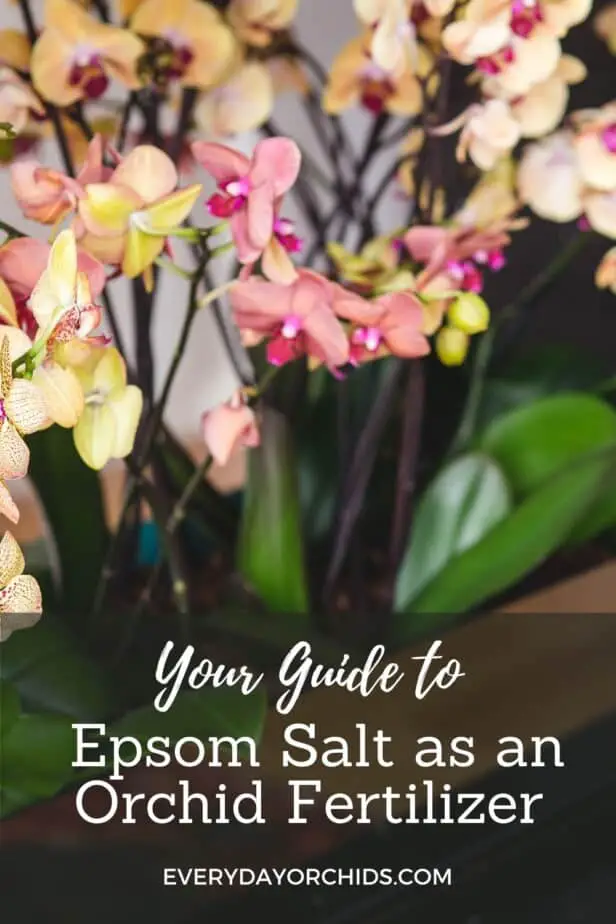Epsom salt is a great way to boost your orchid’s nutrition and health. In fact, Epsom salt can be used on all plants, including orchids. If you are looking for an inexpensive and easy way to supplement your orchid’s nutrition, Epsom salt could be a good option. Keep reading to learn more!
You can use Epsom salt on your orchids to boost growth and flowering. Dissolve 1 Tablespoon of Epsom salt in 1 gallon of water and mix well. You can use this mixture to soak your orchid roots, water your terrestrial orchids, or mist the leaves and foliage of your orchids. This can be done once a month or once every other month to supplement your regular feedings with orchid fertilizer.
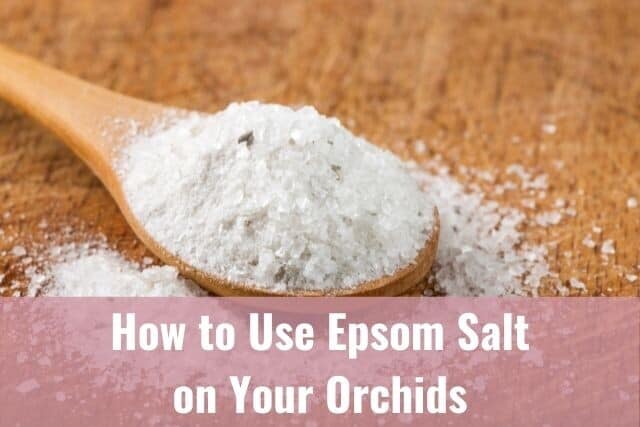
There are many reasons to use Epsom salt to feed your orchid plants. Increased growth and flowering are just two of the many benefits to using Epsom salt in horticulture.
I’ll go over what Epsom salt is and why it is so beneficial to plants. You’ll learn how to dilute it for use on orchids, how often to use it, and what you can expect to see in your orchids. Keep reading to learn about this inexpensive fertilizer option for orchids.
Please note that these links are affiliate links and as an Amazon Associate, I earn from qualifying purchases. Purchases made through affiliate links in this post may generate commissions at no additional cost to you. Use this link for a discounted Amazon Prime trial. Thank you for your support!
Table of Contents
What is Epsom Salt?
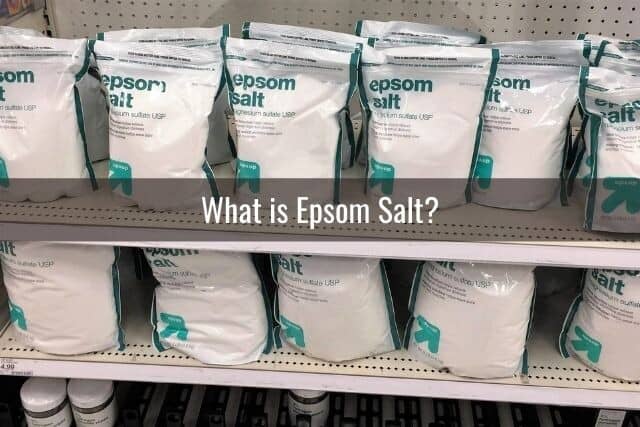
You may have heard of Epsom salt and are wondering how you can use it. There are a few things you should know before you start.
First of all, let’s be clear. Epsom salt is not table salt. It is completely different than the salt we use in cooking and eating. In general, you should not be using Epsom salt for regular consumption.
Constipation Treatment
One of the main reasons why Epsom salt should not be used for regular consumption is that it is a laxative. Yes, people use this to treat constipation. Epsom salt can be used as a saline laxative to get those bowels going. This is done by dissolving a small amount of Epsom salt in a glass of water.
Drinking this will help address the constipation issues. However, this is also why you do not want to be using Epsom salt as a substitute for kosher or table salt. Repeat, not for regular consumption! For this reason, it is also a good idea to keep your bag of Epsom salt away from pets and young children.
Soothes Muscle Aches
Instead, Epsom salt is traditionally used in baths to help treat minor aches and sprains. To use Epsom salt in this manner, simply pour a generous amount of Epsom salt into running, warm bath water. Allow it to dissolve. Then, relax in the bath and allow the Epsom salt and warm water to help relieve your aching muscles.
Many people buy Epsom salt in bulk for use in baths. It can be quite inexpensive and is generally less than a dollar per pound. You can buy Epsom salt online or at your grocery or drug store. Since it is used to treat muscle aches and pains, it is usually placed near the first-aid supplies.
Gardening Use
A little goes a long way, especially if you are buying it for gardening and orchid use. Did you know Epsom salt can be used for plants too? This is a less common use of Epsom salt, but it can work wonders for your plants.
Epsom salt consists of magnesium sulfate, which is an essential nutrient for plants. You can use Epsom salt in moderation to supplement your regular orchid fertilizer. I’ll dive in to this further below.
The Role of Magnesium Sulfate in Plant Health
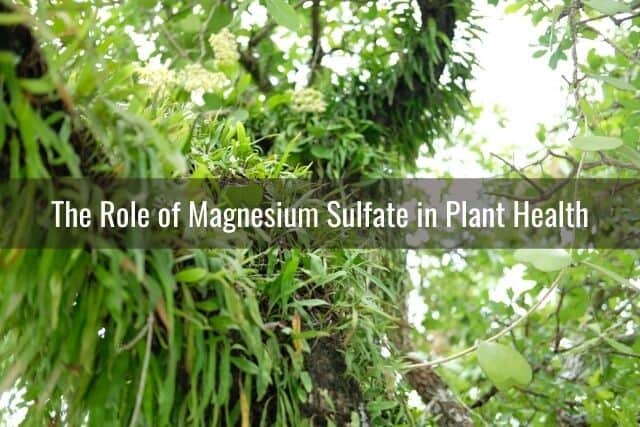
Epsom salt contains magnesium sulfate. To better understand why Epsom salt is so beneficial to plants, we have to understand what magnesium sulfate does for plants.
Chlorophyll Production
Magnesium sulfate helps increase chlorophyll production in plants. By increasing chlorophyll production, plants are able to absorb more light. This, in turn, allows the plant to harvest more energy and turn it into glucose, or food, for the plant. The end result is better growth. Higher levels of chlorophyll will also cause the plant to appear greener and more vibrant.
If you notice that your plant’s foliage is turning yellow or curling, this may indicate a magnesium deficiency. Orchid leaf tips can turn brown due to low magnesium levels.
That said, orchid leaves can change color for multiple reasons, so it is best to do some research first. Use the process of elimination to find out if low magnesium levels are what is causing your orchid leaves to turn yellow or brown.
Flower and Leaf Growth
Magnesium sulfate also encourages flower growth and leaf growth in plants. Epsom salt contains magnesium sulfate and provides plants with key nutrients that are beneficial for plant health and growth.
If you notice that your plants have stunted growth and decreased flower or fruit production, nutrient deficiency may be the cause. Specifically, low magnesium levels may be to blame.
You can test this theory out by supplementing your plants’ nutrition with small amounts of diluted Epsom salt (see dilution instructions below). Do this a few times over several months and observe to see if that solves the problem.
Helps Plants Absorb Key Nutrients
The presence of magnesium sulfate helps plants better absorb key nutrients, namely nitrogen, phosphorus and sulfur. I talked about some of these key nutrients in my article about how to fertilize orchids.
- Nitrogen helps promote the growth of leaves.
- Phosphorus helps plants grow more roots and flowers.
- Sulfur is essential for plants to produce vitamins, proteins and enzymes, all of which are used in the plant’s growth processes.
As a result of this, magnesium sulfate can be used to supplement regular fertilization. It will help plants absorb the nutrients from the fertilizer better. Since plants will be able to absorb all the fertilizer, the plants end up stronger and healthier. A stronger and healthier plant will be more able to fight off infections and pest infestations.
Natural Pest Deterrent
Using Epsom salt on and around your plants can help deter pests naturally. If you are having issues with pests in your garden, you can use Epsom salt to keep them away. Simply mix 1 cup of Epsom salt in 5 gallons of water and apply this onto the plant foliage.
If slugs and snails are a problem, you can sprinkle Epsom salt directly on the soil around your plants. This is especially useful if you have terrestrial orchids.
If you already have a pest infestation on your orchids, check out my article on how to get rid of orchid pests. There, I help you figure out what kind of pest is on your orchid plant and how to get rid of it.
Epsom Salt for Orchid Use
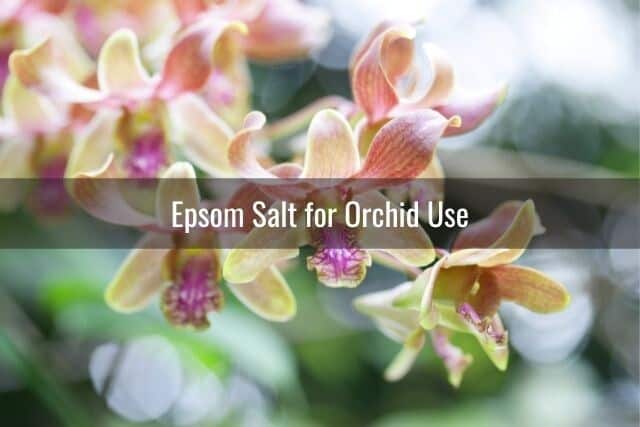
All of the benefits of Epsom salt mentioned above apply to orchids as well. After all, orchids are plants! By using Epsom salt for your orchids, you will see increased flower production, more leaf growth, and more root growth in your orchids. This is because the magnesium sulfate helps the plant absorb key nutrients such as nitrogen and phosphorus.
If Epsom salt solution is applied a few months before the blooming season begins, your orchid may bloom more frequently. When it does bloom, it may produce larger blooms. Some orchid growers have also reported that their orchid blooms last longer as well.
With the addition of Epsom salt, orchids will have more chlorophyll production. As the orchid is able to gather more energy, it can put that into growth of leaves, roots and flowers. This leads to better growth and a healthier, stronger orchid plant overall. The leaves will look greener and healthier. Your orchid will be better able to withstand disease, infestations, and temperature stressors. All in all, it is a win win situation.
If your orchid roots are severely dry or dehydrated, Epsom salt can help rejuvenate them. Soaking the orchid roots in an Epsom salt solution will rehydrate dried orchid roots. I will go into more detail on how to do this below.
Occasional watering with a diluted Epsom salt solution will also help flush out any excess fertilizer salts and leftover residue. These residual salts may be leftover from your regular orchid fertilizer.
Epsom salts can be used to supplement your orchid fertilizer. You can incorporate this into your regular orchid fertilization schedule. Next, I will go over how you can prepare Epsom salts for your orchids and when to use it.
How to Prepare Epsom Salt for Orchids
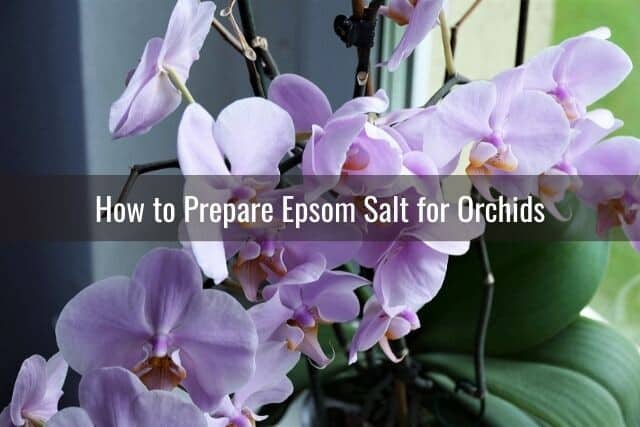
Interested in trying out Epsom salt as a supplement to your orchid fertilizer? To start, you will need to know how to prepare it and apply it.
To prepare Epsom salt for your orchid plants, mix 1 tablespoon of Epsom salt in 1 gallon of water. Mix well, until the salt has fully dissolved.
Set your orchid pots into a small bucket or basin. Pour the dissolved Epsom salt mixture into a shallow basin, up to the top edges of the orchid pots. For routine feeding, allow your orchids to sit and soak in this Epsom salt water for at least 10 minutes.
When diluted in water, magnesium sulfate is readily absorbed through the leaves and foliage. You can put the Epsom salt water preparation into a spray bottle and use it to spray your orchids’ leaves. Just be careful not to let water drip down the leaves and settle into the orchid’s crown. If this happens, just dry up the water with a napkin to prevent crown rot.
Terrestrial Orchids and Epsom Salt
If you have terrestrial orchids planted in your garden, you can apply this mixture to the potting media and soil around the orchid roots. Commercial fertilizers used over time can lead to a build-up of fertilizer salts and residue left in the potting media. Fortunately, you don’t have this problem with Epsom salt.
Be aware that magnesium is generally found in most fertilizers in trace amounts. If you are unsure if your orchid needs more magnesium sulfate, you can start with a half-strength Epsom salt solution (1/2 Tablespoon in 1 gallon of water). After applying this to your orchid plants, you can observe for any changes. Do this a few times over several months before coming to a conclusion.
If it seems that the Epsom salt solution has improved your orchid plants’ health, go ahead and use the full-strength Epsom salt solution (1 Tablespoon in 1 gallon of water) next time.
How Often Should You Use Epsom Salt on Your Orchids?
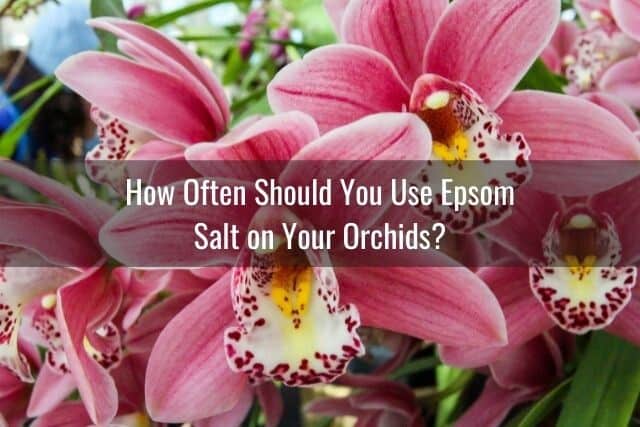
You do not need to use Epsom salt on your orchids very often.
If you are regularly watering your orchids each week, then every fourth or fifth week, add in an Epsom salt solution to your routine.
Basically, if you are fertilizing your orchids “weekly, weakly,” take a break on that fourth or fifth week. Simply water your orchids with plain water, then follow this with an Epsom salt mixture (dissolve 1 Tablespoon in 1 gallon of water).
By skipping a week of regular fertilization, the plain water can flush out residual fertilizer salts and residue from the orchid pots. The diluted Epsom salt solution can help flush out residue as well.
Applying the Epsom salt solution will also help the orchid better absorb the nitrogen, phosphorus and sulfur present. This will enhance the effects of your regular orchid fertilizer.
The next watering after this (on the following week) can be with plain water as well if you prefer. This would be to continue to flush out any residual fertilizer salts. After this, you can return to your regular orchid fertilizing schedule and start this process all over again.
When it’s all said and done, if you follow this routine, you may end up using Epsom salt on your orchids just a handful of times a year. You will use Epsom salts more frequently during growth periods or when the weather is warmer and watering is more frequent. Follow the schedule mentioned above, using Epsom salt every fourth or fifth watering in place of your fertilizer.
Wintertime and Dormancy
When your orchids slow down their growth during the fall and enter dormancy during the winter, you will decrease your watering schedule. Most likely, you will just fertilize your orchids once or twice a month. During this time, you can stop using Epsom salt on your orchids. Just restart in the spring, when growth picks up again.
Dehydrated Roots
If you notice that your orchid roots tend to get dehydrated, use Epsom salt to help rehydrate the roots. As mentioned above, use Epsom salt every fourth or fifth watering session. Normally, you would soak the orchid pot in the Epsom salt solution for at least ten minutes. In this case, leave the orchid pots in the solution for up to three hours.
Do this early in the morning. This will give the orchid potting media time to dry out before nightfall. Soaking your orchid roots in this Epsom salt mixture just a few times a year will be more than enough to keep them hydrated.
If dry and shriveled orchid roots continues to be a problem despite this intervention, check the humidity levels in your home. Most orchid plants prefer humidity levels anywhere from 40% to 80%, depending on the species. Make sure your orchid isn’t sitting in a drafty area or near a heater. Stick to a regular watering schedule. Consider investing in a humidifier or using a humidity tray under your orchid pots. Read more about ways to increase humidity for your orchids here.
Can You Use Epsom Salt for Other Plants?
The answer is yes! You can definitely use Epsom salt on your other plants, both indoor and outdoor. As mentioned earlier, there are many benefits Epsom salt has for plants.
Indoor Plants
For indoor houseplants, dissolve 1-2 Tablespoons of Epsom salt in 1 gallon of water. You can use this once a month to fertilize your indoor plants. You can place this dissolved solution in a misting bottle and spray the foliage.
Magnesium sulfate, in the form of Epsom salt, is readily absorbed by plants when misted onto plant leaves and foliage. You can also apply this directly to the soil.
Outdoor Plants
You can also use Epsom salt on lawns, shrubbery, trees, roses, and more. Epsom salt can be used to kick start your vegetable and flower garden. Tomatoes and peppers, in particular, enjoy higher levels of magnesium in the soil.
Dissolve 1 Tablespoon of Epsom salt in 1 gallon of water for outdoor plants. Apply this as a foliar spray on your tomato and pepper plants.
Alternatively, you can scatter 1 Tablespoon of Epsom salt around each plant. As you water your plants, these salt granules will dissolve and add magnesium sulfate to the soil.
Roses
Roses also prefer higher magnesium sulfate levels. Similar to the tomato and pepper plants, you can dissolve 1 Tablespoon of Epsom salt in 1 gallon of water and apply this as a foliar spray to your rose bushes.
This can be done each spring as leaves start to appear on the rose bush. You can repeat this treatment again after the rose bush is done flowering and is in its growth phase.
Final Thoughts
If you haven’t tried using Epsom salt on your orchids yet, what are you waiting for? It is relatively inexpensive and a little can go a long way. I just bought a 4-pound bag of Epsom salt at my local Target for under $3. This will probably last me for years if I were to use this on my orchids alone. Most likely though, I will use this bag on all my plants, especially my vegetable garden (tomato plants love magnesium sulfate!) and roses. Give it a try and see what happens!
If you enjoyed this article, please pin it and share!

